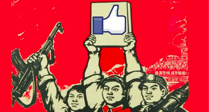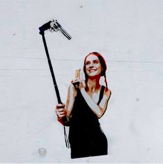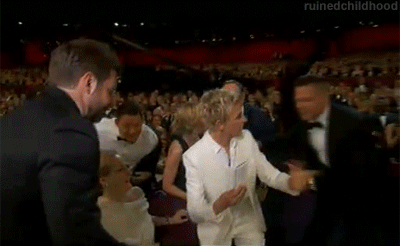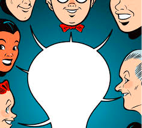Forms of ‘sociality’ that successive social media tools and platforms enable
Don't wanna be here? Send us removal request.
Link
It will be interesting to see if the crackdown will drive adoption of circumvention technology
4 notes
·
View notes
Text
Activism + slactivism = voices heard
To those of us who couldn’t be at the Women’s March protests because we are in the hospital, or chronically ill, or disabled, for those of us who are young and in families that would disown us for going out and protesting, for those of us who are working low paying jobs and would be fired if we called out, for those of us who would be in danger for protesting but who are supporting those who are, who are protesting online and in person and in our classrooms by starting conversations and becoming educated on social justice, who are donating, who are coming to our workplaces with feminist and BLM pins or shirts, who are doing everything they can but cannot be there physically today: you are not taking part in slacktivism: you are doing everything you can and we stand with those currently at the Women’s Marches!
45 notes
·
View notes
Text
The Great Firewall of China
By three methods we may learn wisdom: First, by reflection, which is noblest; Second, by imitation, which is easiest; and third by experience, which is the bitterest. Confucius

The Great firewall of China was designed to defend the Chinese communist regime from external values, by preventing Chinese citizens from accessing the global free Internet. Michael Anti (TED, 2012) describes this as ‘two internets, one is the Internet, the other is the Chinanet’. With an online population of over 500 million, ChiNetizens have access to cloned versions of Google, Facebook, twitter, Youtube and Louis Vuitton. This counterfeit culture sees the Chinese cherrypick and tweak the best of capitalism while steadfastly clinging to the ‘temporary' authoritarian control of communist ideology through its censorship laws.
Censorship - ‘What the government uses to keep the dumb masses from finding out the truth about its corruption and incompetence’ (AYB, 2003).
Censorship is the number one political tool of authoritarian regimes, with countries such as China, Iran, North Korea and Australia using censorship to filter out a prescribed list of websites deemed prohibited using techniques such as IP blocking and keyword content inspection’ (Travaglione, 2009). China’s tight control of its server has created many opportunities for Chinese businesses, citizens, and the government. Businesses have created hybrid models of microblogging sites, and found more efficient ways to target their advertising; netizens have developed a new language of ‘code words, homonyms and purposeful misnomers to avoid censorship’ (DLD conference 2013) and Chinese officials have learnt that ‘twitter is a good way to start rumours and purge political insurgents’ (TED, 2012).
Ai Weiwei, China’s most famous political activist, has high hopes that the internet will achieve a ‘civil society and get young people to be engaged through continued civil opinions and discussions’ however, as China’s youth leads the ‘convergence of the offline and online worlds; where it is less important to distinguish between what happens online from the real world,’ will they remain placated by online shopping and and a more expansive online friendship circle? (Crampton, 2011)
Chiu, Lin and Silverman's (2013, p. 1) assertion that China is leading the charge in the social media boom evokes images of some poor capitalist chasing after them with a worthless patent scrunched up in their fist. While lack of innovation can stultify a culture’s evolution, it can do the exact opposite for its economy. Appropriating and improving products is one of the most successful business models, and in this China is leading the way. Hopefully this misappropriation of Western concepts extends to increased freedom for the next generation.
References
AYB 2003, ‘Censorship’, Urban Dictionary, April 03, viewed 30 January 2017, <http://www.urbandictionary.com/define.php?term=censorship>.
Chiu, C, Lin, D & Silverman, A 2012, China’s social-media boom, McKinsey & Company, viewed 3 August 2016, <http://www.mckinsey.com/insights/marketing_sales/chinas_social-media_boom>.
Ai Weiwei 2012, he Internet vs. The Chinese Government, 31 October, viewed 30 January 2017, <https://www.youtube.com/watch?v=HtDTPZX8IRQ>.
DLDconference 2013, DLD13 - How Social Media is changing China and Asia, 7 February, viewed 3 August 2016, <https://www.youtube.com/watch?v=rG3z2ucaR6A>.
Crampton, T 2011, ‘Social media in China: The same, but differen’t, China Business Review, Vol. 38, no. 1, pp. 28-31, viewed 3 August 2016, <http://www.thomascrampton.com/china/social-media-china-business-review/>.
TED 2012, Behind the Great Firewall of China, June, viewed 3 August 2016, <http://www.ted.com/talks/michael_anti_behind_the_great_firewall_of_china>.
Travaglione, K. (2009). Internet Censorship in Australia - A ‘clean-feed’?. [online] mannkal.org. Available at: http://www.mannkal.org/downloads/scholars/internet-censorship-in-australia.pdf [Accessed 30 Jan. 2017].
Images
'China Social Media Banned But Not For Communist Party' N.D, [image], Democracy Chronicles, viewed 30 January 2017, < https://democracychronicles.com/china-social-media-banned/>.
1 note
·
View note
Quote
If Pac-Man had affected us as kids, we’d all be running around in dark rooms, munching pills and listening to repetitive electronic music.
Marcus Brigstocke
1 note
·
View note
Text
Social gaming: Playing the crowd
‘I am a Gamer, not because I don’t have a life but because I choose to have many’ (unknown,nd)

It was a typical Melbourne summer day, muggy, soaring temperatures, men using their ties as sweatbands. I squeezed into an overcrowded tram looking for an elusive patch of seat that I might be able to rest half a buttock on. His noise cancelling headphones held back his greasy hair like an Alice band, and a vague aroma of overflowing-laundry-basket-in-a-room-with-no-windows emanated from his gothic uniform. As I snuggled under his armpit, almost squashing his grocery supplies of 2-minute noodles and Twisties, he remained transfixed by his mobile screen. Gamer, I thought as I practiced shallow breaths and reminisced about my own battle with gaming addiction. It was the winter of 2014, East Germany, snow flakes fell like frozen tears on my cheeks as I was turned away from yet another job. Lacking the basic language skills to be of service to any organisation I sought solace in the delusion of productivity…. FarmVille.
Toiling on the farm can be a solitary life, I failed to take advantage of the social aspect of the game. The makers of FarmVille see themselves as the pioneers of social games, ‘the ability to play with your friends is what we consider first and foremost whenever we are designing a game’ (Zynga, 2014). I managed to wean myself off FarmVille after six months of complete immersion, someone had suggested that FarmVille is a gateway drug, leading to MUDs or even worse… MMORPG. Once you end up in ‘Multi-user dungeons’ or ‘Massively multiple online role-playing games’ there is no coming back.
Games like EVE Online are so consuming that during times of crisis people have been known to take time of work to win back lost battlegrounds Thornhill (2014). It is a ‘lawless frontier, where players are rewarded for ruthless gameplay, including murder, sabotage and piracy… the question arises, how do players negotiate rules and norms of behaviour within such a consciously amoral context?’ (de Zwart & Humphreys 2014 p. 82). The process of forming codes within digital communities is one of identifying norms, understanding their evolution, considering disputes and consent. Complex codes of behaviour are crowdsourced from the gaming participants. ‘Shy individuals who feel more comfortable in online spaces learn valuable negotiation and interaction skills and broaden their friendship circles’ (Kasumovic, 2014).
As I disembarked from the tram I couldn't help but notice the after-work crowd also transfixed by their mobile phones, Candy Crush featured on quite a few screens and I realised that online and offline lives are all around us.

References
de Zwart, M & Humphreys, S 2014,' The Lawless Frontier of Deep Space: Code as Law in EVE Online', Cultural Studies Review, vol. 20, no. 1, pp. 77-99.
Kasumovic, M 2014, Gamer disclaimer: virtual worlds can be as fulfilling as real life, The Conversation, 15 August, viewed 26 January 2017, < http://theconversation.com/gamer-disclaimer-virtual-worlds-can-be-as-fulfilling-as-real-life-29571>
Thornhill, T, 2014, 'The online videogame battle that cost $300,000: Gamers see hundreds of costly spaceships destroyed after user forgot to pay bill to defend their base', The Daily Mail, 29 January, viewed 3 August 2016, <http://www.dailymail.co.uk/news/article-2547908/EVE-online-sees-biggest-battle.html>.
Zynga, 2014, viewed 3 August 2016, <www.zynga.com>.
Images
‘Retro gamers' n.d., [image], Wallpaper Gallery, viewed 26 January 2017, < http://wallpaper-gallery.net/single/gamers-wallpaper/gamers-wallpaper-10.html >.
0 notes
Link
An interesting Blog on the power of visual content to improve businesses. Tip number one - Don’t TELL if you can SHOW
1 note
·
View note
Text
Visual communities and social imaging
"One of the greatest gifts you can give another person is your attention.'' (Lange 2006)

I have a cousin-friend whose disregard for his public image is so complete, that I sometimes have to avert my eyes when he pops up on my Facebook feed. If I didn't know him better I would suspect that one of his exes had hacked his account and gone on a vindictive trolling spree. There is no delineation between his public and personal life and as such he leads a life of unfiltered abandon. The problem is that his spontaneous photography and prolific posts have caused some of us to to increase our security settings in order to control our own images, his tags don't paint a pretty picture of my mother’s daughter, and I don't want to have to explain to her why Im ‘just holding somebody else’s cigarette’ again. This lack of control isn't just limited to my friend’s indiscretion, ‘social media platforms are like ‘curators’ of a personal ‘exhibition’ with a subsequent loss of control over the distribution pathways for all personal content.’ (Vivienne & Burgess 2013) and yet with all the drawbacks, social media is one of the best ways to stay connected; pictures tell those ‘thousand words’ that I have neither the time nor inclination to write.
social media platforms like Snapchat have become a fundamental form of communication through images rather than commentary. A function of the app is that the image will appear fleetingly, replicating natures transient perspective, before removing it from the public sphere. ‘Digital dualists believe that the digital world is “virtual” and the physical world “real,’ however Herrman (2014) cites Jurgenson’s belief that this is ‘no longer relevant, social media is no longer limited to recording offline experiences and then posting them online to recreate the experience.’
Before the advent of the digital camera, photo editing software and the internet, philosopher Jean Baudrillard wrote about the ‘hall of media mirrors in which reality has been lost in an infinity of reflection; ‘in the desert of the real, mirages outnumber oases and are more alluring to the thirsty eye’ (Dery 2010). People conceal the drudgery of their lives behind filters, challenge business models by becoming producer rather than patron and subvert the meaning of text through manipulation of universally understood images. Visual expression has always been a powerful form of communication, kids learn to draw before they write and interpret the world through images before they have the vocabulary to express themselves. Cave drawings were the earliest form of posting on someones wall, so it stands to reason that now that we have affordable technology we will proliferate the innate.

References
Dery, M 2010, Culture Jamming: Hacking, Slashing, and Sniping in the Empire of Signs, Shovelware, viewed 3 August 2016, <http://markdery.com/?page_id=154>.
Herrman, J 2014, ‘Meet the Man Who Got Inside Snapchat’s Head’, BuzzFeed, 28 January, viewed 3 August 2016, <http://www.buzzfeed.com/jwherrman/meet-the-unlikely-academic-behind-snapchats-new- pitch#3dlvjg2>.
Lange P 2006, ‘What's your claim to ame?’ First Monday, vol. 11, no. 9, viewed 3 August 2016, <http://www.uic.edu/htbin/cgiwrap/bin/ojs/index.php/fm/article/view/1393/1311>.
Vivienne, S & Burgess, J 2013, ‘The Remediation of the Personal Photograph’, Journal of Material Culture, vol. 18, no. 3, pp. 279-98.
Images
‘Banksy Selfie ‘ [Image], Pinterest, viewed 20 January 2017<https://au.pinterest.com/pin/513058582527489709/>
1 note
·
View note
Text
Crowdsourcing in good times and bad
“how do we incentivise a global assembly of brilliant minds to dismantle the malignant culture of secrecy?” (Nielsen 2011)

‘Crowdsourcing is the practice of obtaining services, ideas and content via contributions from a large group of online individuals and groups’ (Merriam Webster Online 2014).
Social media platforms such as Facebook and Twitter can be swiftly employed during times of crisis, to inform and enhance communication and response potential. Large swathes of valuable information can be collated into mapping services like Ushahidi, however the authenticity of user generated content can not always be verified at short notice Ford (2012, pp 35-39).
Emergency information, traditionally distributed via TV or radio is increasingly disseminated via social media platforms. Ushahidi is a map-based crisis-crowdsourcing platform, relying on valuable location-based information and was tentatively deployed by the ABC during the Queensland floods Posetti & Lo (2012).
While the full potential of crowdsourcing is still in its infancy, the transformative possibilities for future applications are revolutionary. Iceland is turning to crowd-sourcing its constitution, allowing citizens to ‘remain constantly involved in shaping the rules that govern their society. In doing so they hope to redress the balance of power between citizens and government’ (Kinna, Prichard and Swann, 2016).
Further to the limitless possibilities of crowdsourcing, are movements within the scientific community to share research and expedite life-saving cures. ‘Scarce funding has created a competitive environment obsessed with the publication of peer reviewed papers’ (Nielsen, TED 2011).
Emphasis on publication incentivises scientists to hoard their work, while parallel laboratories skulk in the shadows, re-inventing the wheel instead of pooling their resources via the two principles of open-source science and crowdsourcing.
(Nielsen, TED 2011) recommends “Any publicly funded science should be open science,” however, without government intervention the solution may lie in the answer to the following question,
“how do we incentivise a global assembly of brilliant minds to dismantle the malignant culture of secrecy?” Is the incentive money? accolades?
Perhaps each disease could have its own crowdfunding page attached to an open-science forum. The charitable donations could be held as jackpot until a cure is found, then distributed on percentage basis amongst the contributing scientists.
Perhaps I need to crowdsource the answer. How would you incentivise an industry subjugated to whims of a self-interested benefactor?
The possibilities are endless, crowdsourcing is a utopian alternative to our current political shortcomings, it could be used to circumvent capitalist restraints, re-imagine socialism or simply ‘define social challenges and put them out to volunteer technologists to solve’ (Random Hacks of Kindness, 2014).
youtube
References
'crowdsourcing entry' 2014, Merriam Webster, viewed 3 August 2016,<http://www.merriam- webster.com/dictionary/crowdsourcing>.
Ford, H 2012, 'Crowd Wisdom', Index on Censorship, vol. 41, no. 4, pp. 33-39.
Kinna, R., Prichard, A. and Swann, T. 2016. Iceland's crowd-sourced constitution: hope for disillusioned voters everywhere. The Conversation, 28 October, viewed 12 Jan. 2017, http://theconversation.com/icelands-crowd-sourced-constitution-hope-for-disillusioned-voters-everywhere-67803
Postetti, J & Lo, P 2012, The Twitterisation of ABCs Emergency & Disaster Communication, Australian Journal of Emergency Management, Vol. 27, no. 1, pp. 34-39.
Random Hacks of Kindness 2014, viewed 12 January 2017, <http://www.rhok.org/>.
TEDx Talks, 2011, Open science: Michael Nielsen, 6 April, viewed 12 Jan. 2017, <https://www.youtube.com/watch?v=DnWocYKqvhw>
TEDx Talks, 2011, Open science: Jay Bradner, 27 October, viewed 12 Jan. 2017, < https://www.youtube.com/watch?v=wOiKRVH0nQ8 >
Ushahidi 2014, viewed 12 January 2017, <http://www.ushahidi.com/>.
Images
doodletilt.tv 2012, 'Crowdsourcing in government: Can it really work?' [image], Linking Asia 21, viewed 12 January 2017, < http://linkingasia21.net/2012/02/crowdsourcing-in-government-can-it-really-work/>.
Images
doodletilt.tv 2012, 'Crowdsourcing in government: Can it really work?' [image], Linking Asia 21, viewed 12 January 2017, < http://linkingasia21.net/2012/02/crowdsourcing-in-government-can-it-really-work/>.
0 notes
Audio
“I linked up with Beyond Blue during the release of Swear Jar to heighten the awareness of bullying on the net and how shit it really is on Facebook and stuff” Illy
http://www.redbull.com/au/en/music/stories/1331788840061/illy-on-sh*t-talk-and-cyberbullying
0 notes
Quote
Wise men speak because they have something to say; fools because they have to say something
Plato
5 notes
·
View notes
Note
Don't pretend for a moment you're a decent person. You're a professional troll, a hypocrite and a fucking disgrace to humanity. Your only contribution to the world is hate. It may put food on your table, but how you live with yourself is a mystery,
But I don’t even need to put food on the table. I feed on hate, and then I vomit it back over the world in a display of misandry so glorious that all the male tears in the world can’t possibly wash it away no matter how hard they cry.
65 notes
·
View notes
Link
0 notes